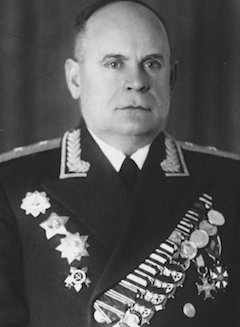Related Research Articles
The 3rd Army was a field army of the Red Army during World War II.

Yevgeny Yakovlevich Savitsky was a Soviet World War II fighter ace who later became a marshal of aviation.

The Byelorussian Military District was a military district of the Soviet Armed Forces. Originally formed just before World War I as the Minsk Military District out of the remnants of the Vilno Military District and the Warsaw Military District, it was headed by the Russian General Eugen Alexander Ernst Rausch von Traubenberg.
The 2nd Baltic Front was a major formation of the Red Army during the Second World War.
A rifle corps was a Soviet corps-level military formation during the mid-twentieth century. Rifle corps were made up of a varying number of rifle divisions, although the allocation of three rifle divisions to a rifle corps was common during the latter part of World War II.
The 16th Army was a Soviet field army active from 1940 to 1945.
The 2nd Air Army was an air army of the Red Army Air Force during the Second World War.
3rd Air Army was an Air Army of the Soviet Armed Forces during the Second World War. It was formed May 16, 1942, in accordance with a People's Commissariat for Defence order of 5 May 1942 on the basis of the Air Forces of the Kalinin Front.
The 6th Assault Aviation Corps was a ground attack formation of the Red Air Force in the Second World War. The corps formed in December 1943. Among the formations part of the corps were the 197th, 198th, 2nd Guards, and 11th Guards Assault Aviation Divisions. It fought in Operation Bagration, the Lublin–Brest Offensive, the Vistula–Oder Offensive, the East Pomeranian Offensive, and the Berlin Offensive. For its actions during World War II the corps was awarded the honorific title "Lublin" and the Order of the Red Banner. Postwar, it was stationed in what would become East Germany. On 10 January 1949 the corps became the 75th Lublin Red Banner Assault Aviation Corps. It was disbanded in 1956 due to the obsolescence of its attack aircraft.
The 269th Rifle Division was an infantry division of the Soviet Union's Red Army during World War II.
The 86th Guards Fighter Aviation Regiment was an aviation regiment of the Soviet Air Forces, and after the dissolution of the Soviet Union, the main formation of the Moldovan Air Force.
The 240th Fighter Aviation Division was a fighter aircraft formation of the Soviet Air Forces during World War II. It saw its most eventful actions during that war, and in 1949 became the 119th Fighter Aviation Division.
The 260th Rifle Division was an infantry division of the Red Army during World War II, formed twice.
The 356th Rifle Division formed in August, 1941, as a standard Red Army rifle division, in the Kuibyshev Oblast. After reaching the front it played a minor role in the defense of Moscow and the winter counteroffensive and remained in the line north and east of the Oryol salient through 1942 and into 1943. It then took part in the offensive to reduce this salient, Operation Kutuzov, after which it advanced towards the Dniepr River through the summer and autumn before becoming involved in the complex fighting in eastern Belarus in the winter of 1943/44, during which it won a battle honor. In the early stages of Operation Bagration the 356th was instrumental in the liberation of Bobruisk, for which it received the Order of the Red Banner. Later during this offensive the division advanced into the Baltic states before being reassigned to 1st Belorussian Front for the final offensive on Germany. Remarkably, the division was assigned to the 61st Army for nearly its entire wartime path. It ended the war north of Berlin, along the Elbe River, but in spite of a fine record of service it was disbanded shortly thereafter.
The 397th Rifle Division was an infantry division of the Red Army, active twice during 1941-45, fighting the German Operation Barbarossa.

Viktor Kazimirovich Urbanovich was a Belarusian Soviet Army lieutenant general.
The 15th Air Army was a military formation of the Soviet Air Forces, active from July 1942 until December 1993.

Viktor Timofeyevich Obukhov was a Soviet Army colonel general and a Hero of the Soviet Union.

Ivan Nikitich Russiyanov was a Soviet Army lieutenant general and a Hero of the Soviet Union.
The 121st Rifle Division was an infantry division of the Red Army during World War II.
References
Citations
- 1 2 Goremykin 2014, pp. 415–416.
- ↑ Niehorster, Dr. Leo. "1st Guards Fighter Aviation Corps, 16th Air Army, 1st Byelorussian Front, 03.04.45". niehorster.org. Retrieved 2017-04-30.
Bibliography
- Michael Holm, 61st Guards Fighter Aviation Corps
- Goremykin, V.P., ed. (2014). Великая Отечественная: Комдивы. Военный биографический словарь[The Great Patriotic War: Division Commanders. Military Biographical Dictionary] (in Russian). Vol. 2. Moscow: Kuchkovo Pole. ISBN 9785995003410.